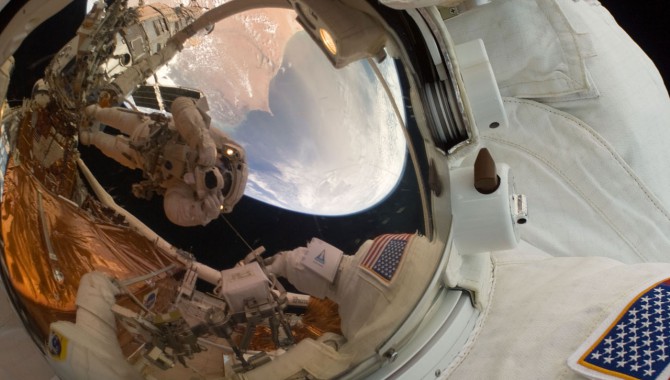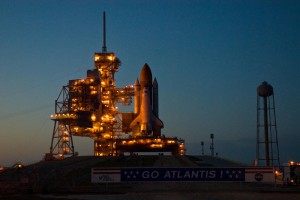
Perched on the robotic arm, Andrew Feustel takes a close-up photo of John Grunsfeld. Credit: STScI/NASA
April 26, 2010 Vol. 3, Issue 4
Former astronaut John Grunsfeld reflects on what the Hubble Space Telescope has taught us over the past 20 years.
Dubbed the “Chief Hubble Repairman,” John Grunsfeld flew three of the five on-orbit servicing missions to the Hubble Space Telescope (HST). Selected by NASA as an astronaut in March 1992, Grunsfeld has flown five space flights total, logging a total of 58 days in space and 58.5 hours of Extra Vehicular Activity over eight spacewalks. During his on-orbit servicing missions, Grunsfeld dealt with everything from installing telephone booth-sized instruments to removing 100-plus tiny screws on Hubble.
Grunsfeld, now Deputy Director of the Space Telescope Science Institute, offered ASK the Academy his thoughts on lessons from Hubble.
ASK the Academy (ATA): You started your career as a scientist in academia before training as an astronaut. How early were you aware that NASA was developing the Hubble? What was your level of interest in it at the time?
John Grunsfeld: I knew that NASA was developing the Hubble Space Telescope while I was in graduate school at the University of Chicago. My PhD thesis was on the flight of Space Shuttle Challenger, STS-51F, the mission before the tragic loss of Challenger and crew. At the time I knew this meant that all missions slated to fly on the Shuttle were in jeopardy. Of course this delay was crucial for the completion of Hubble, but I was at the time more interested in the Compton Gamma Ray Observatory. This next great observatory after Hubble was more central to my field of high energy astrophysics. It is interesting to note that both the Hubble and the Compton depended on astronauts doing spacewalks for the success of the observatories.
ATA: As robotic technology continues to develop, how do you see the division between human and robotic servicing capabilities changing in the future?
Grunsfeld: The constant debate between performing science with robots or people has always struck me as asking the wrong question. We always do science in space now as a human/robotic partnership. It’s only a question of degree. The Hubble Space Telescope has never discovered anything, astronomers using the telescope make the discoveries, and in the case of Hubble, astronauts servicing the telescope have made it orders of magnitude more productive.

Shuttle Atlantis sits on Launch Pad 39A ready to accept the HST payload for STS-125. Credit: NASA/Kim Schifflett
For locations that people can’t go, clearly robots are the way to explore. When we can go, we will go with our robotic counterparts, both of us as pathfinders to extend our reach. The extraordinary robots on the Martian surface now have proven to be great tools for exploration, in as much as we can’t go (yet). But the process is very slow and tedious. A real geologist would have performed at a higher level on the surface of Mars in terms of quality science, and done the last five years of science in a week of exploration. Unfortunately, right now we cant send a geologist to Mars.
What is intriguing is that in field of dexterous robotics we are making great strides, such that some of the space servicing that we do now with astronauts will in the future be possible for these capable robots.
ATA: As one of the pioneers of on-orbit servicing, how do you see these capabilities maturing as NASA and its partners prepare to spend the next decade utilizing the International Space Station?
Grunsfeld: The Special Purpose Dexterous Manipulator on ISS since 2008, and soon the Robonaut-2, provide us with an opportunity to test out in an operational setting the utility of dexterous robotics. We will learn how to use these tools to perform real and simulated servicing on orbit. With their success we can then move out to plan for this kind of capability in future exploration efforts.
ATA: What lessons can we take from Hubble in terms of international collaboration?
Grunsfeld: Our collaboration with the European Space Agency on Hubble has been very fruitful. We work as a seamless team, under the banner of science. These lessons are being applied successfully to the James Webb Space Telescope and form a basis for future collaboration.
ATA: Looking back on the twentieth anniversary of the Hubble launch, what are some of the major lessons learned about the long-term operations of a complex system like this?
Grunsfeld: From a project management point of view, having the opportunity to operate, upgrade, and provide many years of science from Hubble has shown us the value and leverage a space observatory provides as compared to a short-lived, single-purpose space science experiment. The extended team, across centers, institutes, and contractors has consistently risen to meet high-performance challenges across the spectrum of disciplines. The great power of the long-lived nature of Hubble is that the experience has crossed many generations of engineers and scientists who have been able to apply their knowledge to other programs.
NASA APPEL visual timeline of “The Origins of the Hubble Telescope”
View slideshow on Flickr, where you may click Show Info to see detailed image captions.
Origins of the Hubble Space Telescope |
||||
| 1923 | German physicist Hermann Oberth proposes the idea of a large orbiting, multipurpose telescope capable of making observations without atmospheric obstruction. | |||
| 1946 | American astronomer Lyman Spitzer publishes his paper “Astronomical advantages of an extra-terrestrial observatory,” which argues for the advantages of space-based telescopes. | |||
| 1958 | Congress passes the National Aeronautics and Space Act, which authorizes the creation of NASA. | |||
| 1962 | The United Kingdom launches Ariel 1, the first space telescope designed to study solar ultraviolet and X-ray radiation. | |||
| 1962 | NASA initiates the Orbiting Solar Observatories (OSO) program, which is designed to launch a series of satellites to cover the entire 11-year solar cycle. The eighth and final OSO satellite launches in June 1975. The program ends in October 1978. | |||
| 1963 | Stratoscope II, a 36-inch balloon telescope, successfully takes pictures of planets, satellites, and galactic nuclei. It flies its sixth and final successful mission in 1971. | |||
| 1966 | NASA launches the first satellite in the Orbiting Astronomical Observatories (OAO) program. Two of the four satellites in this program fail before or shortly after reaching orbit. The program ends with OAO-3 Copernicus, which operates until February 1981. | |||
| 1969 | National Academies urge construction of a large space telescope. | |||
| 1971 | NASA executive George Low approves feasibility studies by the Large Space Telescope (LST) Steering Group. |
|||
| 1975 | European Space Research Organization (now European Space Agency) partners with NASA on LST. | |||
| 1977 | Congress approves $36 million in funds for the LST program in the FY78 budget. | |||
| 1979 | Astronauts begin training for the mission in underwater tank at Johnson Space Center. | |||
| 1983 | The Large Space Telescope is renamed the Hubble Space Telescope after Edwin Hubble, the astronomer who discovered the expansion of the universe from measurements of the red-shifted spectra of distant stars. | |||
| 1981 | The Space Telescope Science Institute is established in Baltimore to evaluate proposals for telescope time and manage the science program. | |||
| 1985 | Hubble Space Telescope construction completed. | |||
| 1986 | Challenger accident delays Hubble’s October 1986 launch. | |||
| 1990 | Hubble launches on the STS-31 mission aboard space shuttle Discovery on April 24, 1990. | |||
Perched on the robotic arm, Andrew Feustel takes a close-up photo of John Grunsfeld.
Featured Photo Credit: STScI/NASA







